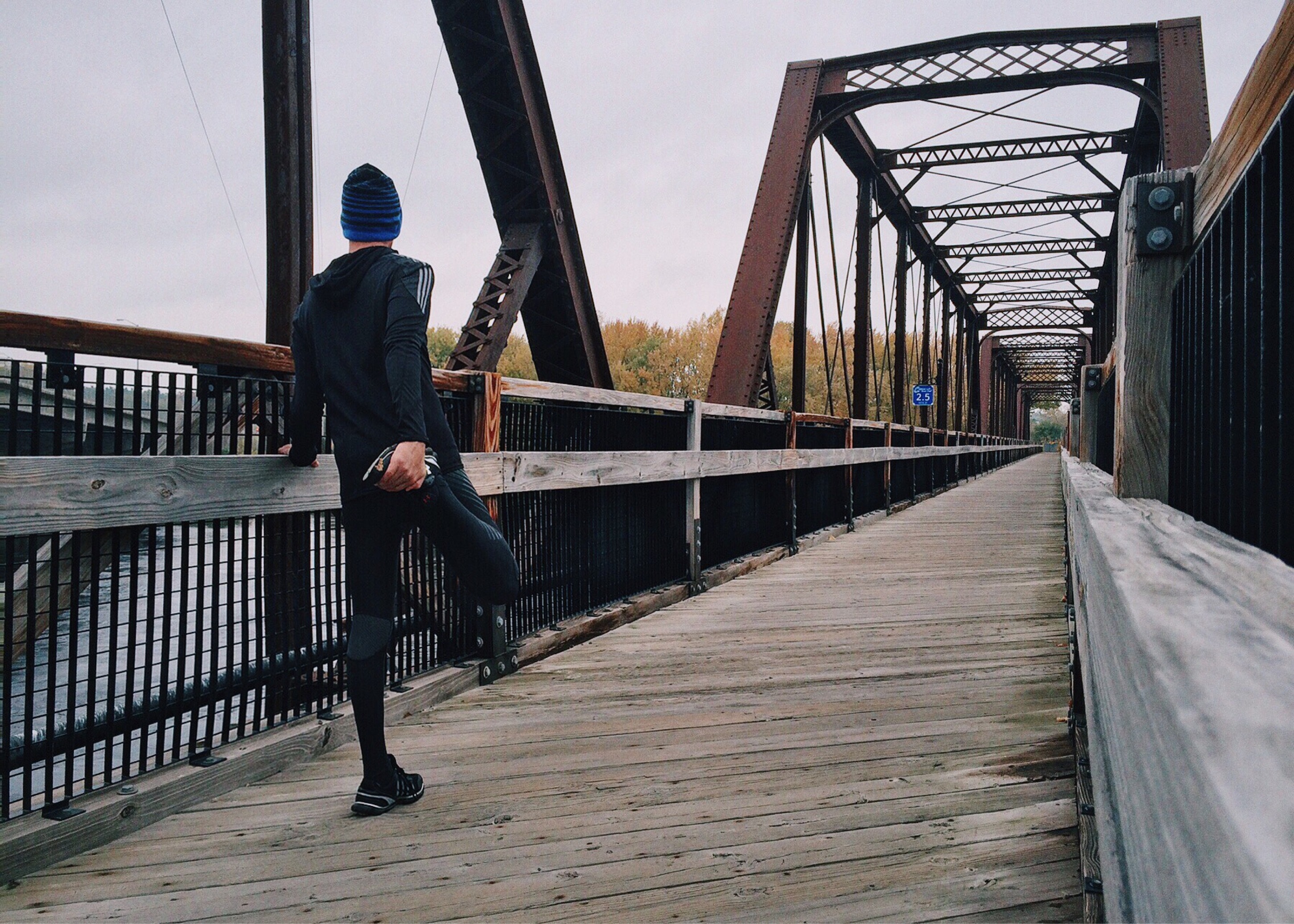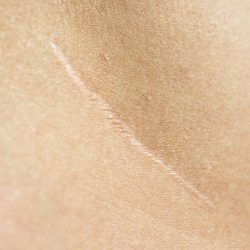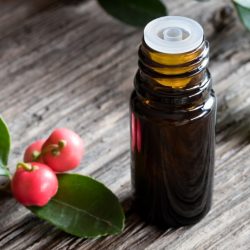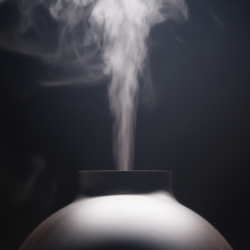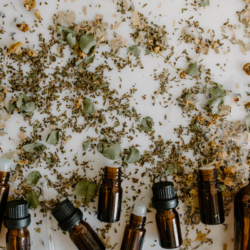Who hasn’t suffered from muscle soreness? After sport or an unusual effort, or following a viral infection, we often feel these pains in the muscles synonymous with the presence of muscle soreness. There’s nothing better than a massage or bath with essential oils to ease the pain and treat muscle soreness.
Muscle soreness can be caused by intense physical effort, prolonged stress or a wrong move. Essential oils are an excellent natural remedy for relieving these aches and pains and promoting recovery. In this article, we’ll look at how to use essential oils to treat muscle soreness.
Metabolism and muscles
What is the energy metabolism?
Energy metabolism is essential for the functioning of the body, providing the energy required for movement, regulation of body temperature and internal metabolic processes. The macronutrients – carbohydrates, fats and proteins – in food serve as sources of energy. Around 60% of this energy is converted into heat to maintain body temperature, while the rest fuels metabolic processes and muscular work.
Adenosine triphosphate (ATP) is the main fuel for muscles, breaking down into adenosine diphosphate (ADP) and a free phosphate during muscle contraction, releasing energy. The ADP is then converted back into ATP, guaranteeing a constant supply of energy. ATP can be resynthesised in different ways, depending on the intensity and duration of the effort.
There are four main types of energy production: creatine kinase, anaerobic glycolysis, aerobic glycolysis and lipolysis. Each uses different sources of energy and depends on the availability of oxygen. Phosphocreatine, a fast source of energy, is used first during physical effort, followed by carbohydrates and lipids.
Anaerobic glycolysis produces energy quickly without oxygen, but generates lactate, which can lead to muscle fatigue. Aerobic glycolysis is slower and uses oxygen to completely break down glucose. Lipolysis aerobically breaks down fats into fatty acids, providing an almost inexhaustible but slow source of energy.
Proteins also serve as a source of energy, especially in cases of deficiency. In sport, the type of energy metabolism varies according to the sport practised and the intensity and duration of the effort. Red muscle fibres are best suited to endurance efforts, while white fibres are optimal for short, powerful movements. Training can influence the composition and performance of muscle fibres.
Definition of a muscle
Muscle is made up of muscle tissue, connective tissue, blood vessels and nerves. Muscle cells, with their actin and myosin filaments, contract to change the length and shape of the cell, producing strength and movement. They play an essential role in maintaining posture, locomotion and the functioning of internal organs, such as cardiac contraction.
There are three types of muscle tissue, derived from the embryonic mesoderm: skeletal, cardiac and smooth. Skeletal muscles contract voluntarily, while cardiac and smooth muscles are involuntary. Skeletal muscle fibres are divided into fast and slow twitch fibres.
Muscles derive their energy from the oxidation of lipids and carbohydrates in aerobic conditions, and from chemical reactions in anaerobic conditions. These reactions produce adenosine triphosphate (ATP), the energy source for muscle movement.
Types of muscle tissue include skeletal muscle, responsible for voluntary movement, smooth muscle, found in organs, and cardiac muscle, unique to the heart. Striated, skeletal and cardiac muscle contain sarcomeres, key structural units, while smooth muscle does not.
The structure of striated skeletal muscle involves various levels of connective tissue: the epimysium, the perimysium and the endomysium. The muscle fibres, made up of myofibrils, contain sarcomeres, giving the muscles their striated appearance.
In physiology, the sarcomeres of skeletal muscles contract and release rapidly, while smooth muscles sustain slower but continuous contractions.
Muscle function depends on the location and insertions of the muscle. The cross-section determines the force generated, and the myofibrils, chains of sarcomeres, shorten during contraction, changing the length of the muscle fibre.
How does muscle work?
Muscles, which account for 30-40% of our body weight, are made up mainly of water (80%), protein (17%), glycogen, lipids and mineral salts (1% each). They require oxygen and ATP (Adenosine TriPhosphate), generated from dietary carbohydrates, to function efficiently.
We have three types of muscle with different functions:
- Striated skeletal muscles: Responsible for voluntary and reflex movements (walking, lifting a leg, grasping objects, etc.).
- Striated myocardial muscles: Essential for heart function and blood circulation.
- Smooth muscles: Operate autonomously in processes such as breathing, digestion and the functioning of the viscera.
Muscles also play a role in shock protection, physical balance and heat production.
The main properties of muscles include :
- Excitability: Response to stimulation.
- Contractility: Capacity to contract and return to the initial state.
- Tonicity: Strength at rest or during activity.
- Elasticity: Ability to stretch and return to its original shape.
These properties vary according to age, sex, build and level of physical activity.
To maintain good muscular health, regular physical activity and sport are essential, along with a good warm-up before exercise and stretching afterwards. Warming up prepares the body for exercise, improves performance and prevents injury. Stretching after exercise promotes recovery, maintains muscle elasticity and reduces the risk of cramp.
What factors influence muscle?
Metabolic factors play a crucial role in muscle contraction, leading to a reduction in the intramuscular energy load and an increase in the AMP/ATP ratio.AMP kinase (AMPK), a sensor of cellular energy status, influences muscle protein synthesis. Activation of AMPK stimulates the expression of genes linked to muscle adaptation, in particular those encoding mitochondrial proteins. Increased AMPK activity during exercise inhibits protein synthesis by reducing the activity of mTOR, a translation regulator. During recovery, there is a rebound in activity, favouring muscle protein synthesis.
Hypoxic Inducible Factor (HIF) and Vascular Endothelial Growth Factor (VEGF), regulated by muscle hypoxia, also influence muscle development. HIF promotes mitochondrial biogenesis, while VEGF stimulates the development of the capillary network.
Nervous factors include the nervous control of motricity, triggering the entry of calcium into the muscle cell and activating calcineurins. Calcineurins, by activating the transcription factor NFAT, influence the metabolic and structural differentiation of muscles. Myogenins, which regulate gene expression of muscle proteins, play a role in muscle response to training.
Hormones also play a decisive role. Steroid hormones, the somatotropic axis and insulin coordinate the development of muscle mass.IGF-1 stimulates the proliferation of satellite cells, contributing to muscle hypertrophy. Thyroid hormones influence muscle fibre typology.
Finally, nutrition is essential for muscle growth. Adequate protein and calorie intake is necessary. Carbohydrates play a role in protein binding, while insulin has an anabolic effect on muscle proteins. Appropriate nutrition, rich in proteins and carbohydrates, is crucial to optimising the effect of physical training.
How do muscle soreness appear?
Muscle soreness can range from mild pain in one muscle group to debilitating pain that affects your daily activities. Muscle aches and pains in sportspeople, i.e. muscle soreness and cramps, occur following unusual physical exercise or activities involving intense muscle contractions. They manifest as pain and stiffness in the muscles involved. They are also linked to micro-lesions or micro-tears in the muscle fibres.
To prevent them from occurring, you should stretch your muscles well and drink plenty of water at the end of your activity. If, despite this advice, the pain persists, it is advisable to use essential oils and massage the sore muscles with a suitable blend of essential oils, followed by gentle exercise (walking, cycling). However, when practising sport, whether occasionally or intensively, it is essential to prepare and recover the muscles and joints. Massages and the use of natural warming and circulatory products considerably improve physical condition .
What is muscle soreness?
Muscle soreness, a common complaint, is the result of inflammation caused by the elimination of waste products accumulated during exercise. This pain is caused by the elimination of waste and repair of damage in the muscle cells, a process that generally lasts 2 to 5 days. They occur a few hours after unusual exertion or in the event of infections such as influenza, making the muscles sensitive to pressure and painful at the slightest movement.
Muscle soreness may be accompanied by muscle contractions, sometimes swelling and warmth to the touch. Although generally benign, they may indicate more serious problems such as muscle strains or tears. Cramps can also occur in connection with conditions such as diabetes, kidney failure or circulatory disorders, and certain medications can make them worse.
Muscle soreness is characterised by pain resulting from physical effort, fatigue or fever, generally appearing 24 hours after the effort. This pain, due to micro-lesions of the muscle fibres, manifests itself as a sensation of stiffness and lasts for about a week.
Muscle soreness can be distinguished from other types of muscular pain:
- Cramps: Painful, involuntary, intense and sudden contractions.
- Contractures: Long, localised pains.
- Elongations: Sudden and very painful pain with tearing.
Symptoms include a dull ache in the affected muscle, often with tenderness or stiffness. This pain, felt when the muscle is stretched, contracted or pressed, typically increases within 24 hours of exercise, peaks between 24 and 72 hours and then gradually diminishes until it disappears after 5 to 7 days. The intensity of muscle soreness is influenced by physical condition and the type of exercise you are used to.
What causes muscle soreness?
The causes of muscle soreness vary and can occur after physical effort, in the event of fever due to a viral infection, or as a result of dehydration. During physical effort, muscles that are not used to working can suffer damage to their muscle fibres, leading to muscle soreness. Fever, such as that associated with flu, provokes an inflammatory reaction in the body, causing muscle soreness. Dehydration weakens the muscles, promoting inflammation. Stress can also cause muscle pain, particularly in the neck and back, through increased muscle tone. In cases such as fibromyalgia, diffuse muscle pain and fatigue lead to muscle soreness, although the exact causes remain unknown.
The consequences of muscle soreness include pain and discomfort, making movement difficult. It can affect performance, reducing range of movement, reducing the ability of muscles to absorb shock, and reducing muscle strength and power. They can also put stress on tendons and ligaments, particularly affecting the thighs and legs after exercise.
The origin of muscle soreness is attributed to microtrauma to muscles and tendons, causing small lesions. These pains are the result of small bleeds caused by the rupture of blood capillaries or lysis of muscle cells. Contrary to popular belief,lactic acid is not responsible for muscle soreness, as it disappears about an hour after exercise.
How can muscle soreness be prevented?
Good hydration is essential to prevent muscle soreness and cramp, especially during sporting activities. It’s important to drink enough before, during and after exercise, including swimming.
Eating foods rich in magnesium, such as chocolate, wholemeal cereals, nuts, pulses and brewer’s yeast, is also beneficial, especially for sportspeople. If you suffer from frequent night cramps due to a lack of water and salt, it is advisable to drink at least one and a half litres of water a day and consult a doctor if you are on a low-sodium diet or taking diuretics.
Warming up and stretching play a crucial role. Before any physical exercise, an effective, long, gradual and appropriate muscular warm-up is necessary, including general stretching and limbering up, as well as movements specific to your sporting discipline. After exercise, it is important to repeat the stretching of the muscles that are most in demand.
For those with little training, it is advisable to avoid overloading the muscles right from the start and to gradually intensify the effort. To prevent muscle soreness, take a few simple steps before and after sport:
- Warm up thoroughly and stretch.
- Drink plenty of water.
- Eat a diet suited to your activity.
- Listen to your body.
The appearance of muscle soreness can be limited or prevented by gradually increasing the intensity of new physical exercises. Although eccentric contractions are inevitable during exercise, especially when muscles are tired, muscle soreness can theoretically be prevented by limiting exercise to concentric and isometric contractions. However, studies suggest that stretching before or after exercise does not eliminate the risk of muscle soreness, and that excessive stretching may itself be the cause.
What are the standard treatments?
Massage therapy can alleviate muscle soreness by reducing the production of cytokines such as TNF-α and interleukin-6, which implicate the immune system in their development.
In the event of aches or cramps, keeping the muscles moving with gentle stretching, cycling or walking will speed up their disappearance. A warm bath and the local application of heat with heating packs or an electric cushion can also soothe the pain. In the case of severe cramps, taking a temporary painkiller may help. To relieve a cramp, stretch the muscle, as by pulling the toes towards the knee in the case of a calf cramp. Walking or bending your legs can also help.
In the case of unexplained muscle pain, the doctor will look for the cause through a thorough examination, which may include looking for muscular or neurological diseases, deficiencies or side-effects of medication. Further tests or treatment with medication may be recommended if the cramps persist.
There are several ways to relieve muscle soreness:
- Rest the muscles: Avoid strenuous sporting activity for 24 to 48 hours after the onset of muscle soreness.
- Apply heat: To improve blood circulation and relax muscles.
- Massage the muscles concerned: This can help relieve the pain.
The pain from muscle soreness generally disappears within 72 hours. To relieve it, low-intensity activities, massages, hot baths or a visit to the sauna can be beneficial. Although cryotherapy is often recommended, its effectiveness is controversial according to studies. Continuous physical exercise can also temporarily suppress pain, a phenomenon known as exercise-induced analgesia, although its effects on reducing soreness require further study.
Importance of essential oils in healing muscle soreness
Essential oils are concentrated plant extracts with numerous health benefits. They are particularly effective in relieving muscle soreness thanks to their anti-inflammatory, analgesic and relaxing properties.
How can essential oils be used to treat muscle soreness?
Essential oils have an exceptional capacity for penetration, as they pass through the skin by osmosis and then quickly (between half an hour and 2 hours) reach the circulatory system via the blood capillaries. In the case of muscular pain linked to aches and pains, the oils chosen should be applied directly to the area to be treated, after diluting them in a volume of vegetable oil. For muscular action, the concentration of essential oil used can be up to 10%. For 30 ml of vegetable oil, you can use 70 drops of essential oils, for example. Massage the painful area with this oil twice a day.
The journal Pain Research and Treatment reported in 2016 that aromatherapy is an effective natural treatment for pain. Studies have shown that using essential oils to treat pain symptoms has helped to reduce chronic pain. For example, using lavender, rosemary and peppermint oil helped reduce pain by around 30% in people with chronic shoulder pain.
There are several ways of using essential oils to treat muscle soreness:
- You can apply essential oils directly to the painful area after diluting them in a vegetable oil (such as sweet almond oil or coconut oil). Massage gently to help the oils penetrate and relax the muscles.
- Mix a few drops of essential oil with a neutral massage oil and massage the painful area to relax the muscles and aid recovery.
- Add a few drops of essential oil to hot bath water, making sure they are well dispersed. Immerse yourself in this relaxing bath to enjoy the benefits of essential oils.
Which essential oils should I choose to treat aches and pains?
- Peppermint Mentha Piperita : The pain-relieving and cooling properties of peppermint essential oil make it an excellent natural pain reliever for sore muscles.
- Lavender Lavandula Angustifolia: the muscle pain-relieving properties of lavender are also good for relieving muscle tension in the arms, thighs or lower back after a workout.
- Chamomile Chamaemelum Nobile helps soothe muscle tension.
- Eucalyptus Mentholé: the cooling effect of eucalyptus essential oil to rub sore muscles and help get rid of aches and pains after training
- Rosemary Rosmarinus Officinalis helps speed up recovery from muscle injuries.
- Wintergreen: Used by many physiotherapists and masseurs for its pain-relieving and anti-inflammatory properties. It relieves muscle or joint pain, rheumatism and tendonitis.
Which plant oils should I choose to treat aches and pains?
When using essential oils for muscle pain, remember that they are actually too powerful to be used directly on the skin. To make your own massage oil at home, you can use one of the following carrier oils:
- Jojoba Plant Oil is a very beneficial oil for your skin due to its constitution, which is very similar to sebum. Jojoba is an excellent carrier oil for analgesic essential oils. It helps the oils to penetrate the skin more easily.
- St John’s Wort vegetable oil can help enhance the pain-relieving properties of many essential oils, as it has an anti-inflammatory effect. St John’s Wort Oil has properties that can help reduce inflammation when applied topically.
- Arnica vegetable oil helps to relieve muscle pain, especially when used with essential oils. Arnica oil is rich in powerful anti-inflammatory compounds. This oily macerate is recommended as a complement to treatments to soothe inflammation. It reduces the formation of bruises and facilitates their resorption. It also soothes and relieves sore areas.
Precautions for use
- Do not use essential oils directly on your skin without diluting them.
- Do not use essential oils if you are pregnant or on young children without first consulting a certified aromatherapist.
- Do not use too much essential oil in a home remedy. 4 drops of essential oil for each tablespoon of carrier oil is generally strong enough.
Seek medical advice for asthmatics and epileptics. An essential oil should not be used by people taking anticoagulants or who are allergic to salicylates (aspirin), people with eczema, asthma, ulcers, hernias or haemorrhages, or those undergoing surgery.
It is also recommended to carry out an allergy test with the mixture as detailed on this page before use.
Essential oils are a natural and effective solution for relieving muscle aches and pains. By using them correctly, you can take advantage of their anti-inflammatory, analgesic and relaxing properties to quickly regain optimum muscle comfort.

